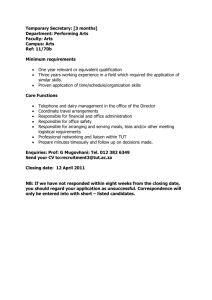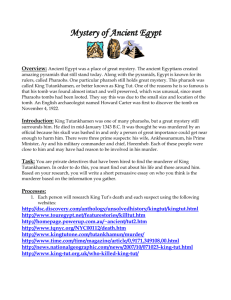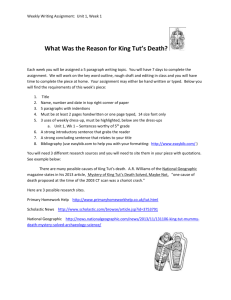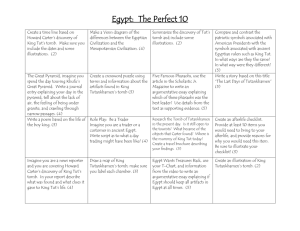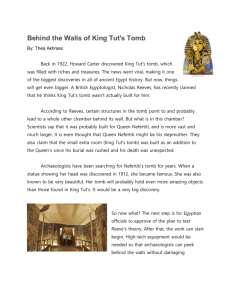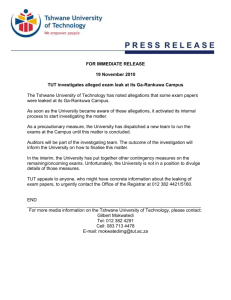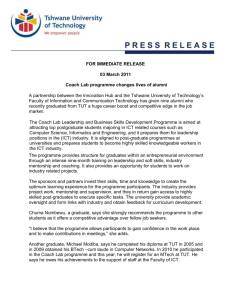Directions for Teachers:
advertisement
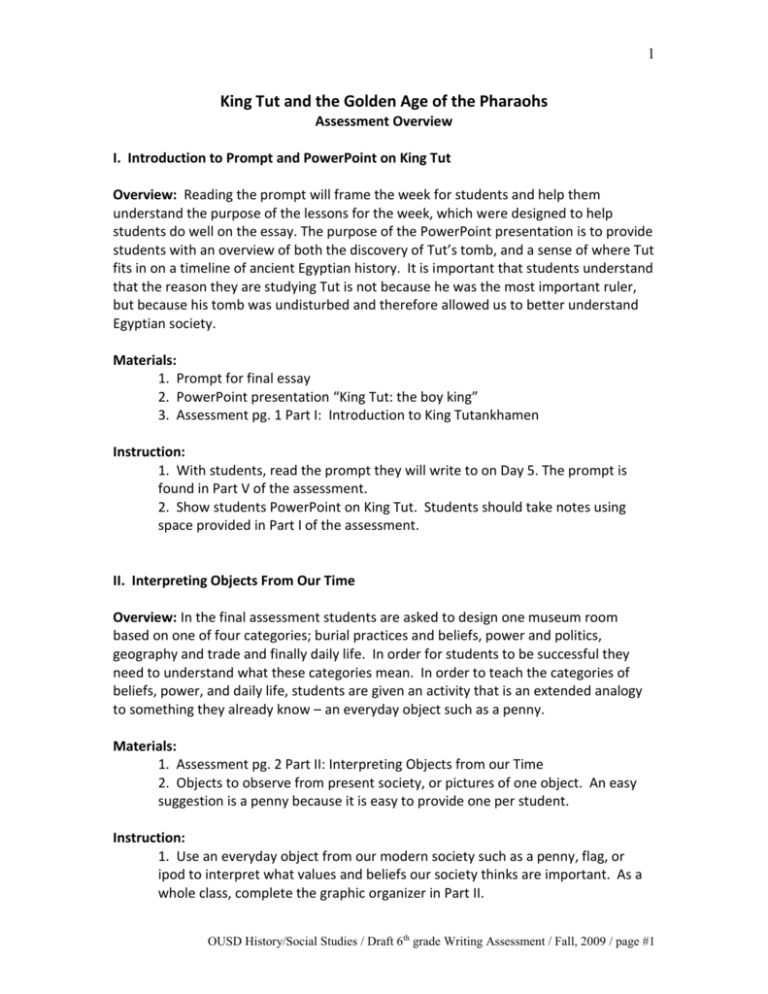
1 King Tut and the Golden Age of the Pharaohs Assessment Overview I. Introduction to Prompt and PowerPoint on King Tut Overview: Reading the prompt will frame the week for students and help them understand the purpose of the lessons for the week, which were designed to help students do well on the essay. The purpose of the PowerPoint presentation is to provide students with an overview of both the discovery of Tut’s tomb, and a sense of where Tut fits in on a timeline of ancient Egyptian history. It is important that students understand that the reason they are studying Tut is not because he was the most important ruler, but because his tomb was undisturbed and therefore allowed us to better understand Egyptian society. Materials: 1. Prompt for final essay 2. PowerPoint presentation “King Tut: the boy king” 3. Assessment pg. 1 Part I: Introduction to King Tutankhamen Instruction: 1. With students, read the prompt they will write to on Day 5. The prompt is found in Part V of the assessment. 2. Show students PowerPoint on King Tut. Students should take notes using space provided in Part I of the assessment. II. Interpreting Objects From Our Time Overview: In the final assessment students are asked to design one museum room based on one of four categories; burial practices and beliefs, power and politics, geography and trade and finally daily life. In order for students to be successful they need to understand what these categories mean. In order to teach the categories of beliefs, power, and daily life, students are given an activity that is an extended analogy to something they already know – an everyday object such as a penny. Materials: 1. Assessment pg. 2 Part II: Interpreting Objects from our Time 2. Objects to observe from present society, or pictures of one object. An easy suggestion is a penny because it is easy to provide one per student. Instruction: 1. Use an everyday object from our modern society such as a penny, flag, or ipod to interpret what values and beliefs our society thinks are important. As a whole class, complete the graphic organizer in Part II. OUSD History/Social Studies / Draft 6th grade Writing Assessment / Fall, 2009 / page #1 2 III. Examining Objects from Ancient Egypt Overview: In these two days students will examine artifacts that were found in King Tut’s tomb. They will use these artifacts, and the readings that accompany them, to draw conclusions about life in ancient Egypt. The activity will begin with the teacher modeling the analysis of the “Fan from King Tut’s Tomb” with the whole class. Students take notes on their graphic organizer with the teacher (p. 3 of assessment). First, students will note what they see in the object just by observing it. Then, they will do a reading on the “Fan from King Tut’s Tomb,” and add more information to their graphic organizer. Finally, they will make inferences and draw some conclusions about life in Ancient Egypt based on the artifact. After modeling “Fan from King Tut’s Tomb,” there are five more objects remaining to analyze. Depending on time and ability level of your students you may choose to model one more object analysis with the class, or you may ask students to complete the analysis graphic organizers in partners or individually. We suggest dividing students into partners and assigning each pair two artifacts to analyze using the worksheet. Materials: 1. Pictures of the following six objects from Tut’s tomb including: Fan fom King Tut’s tomb, Model Boat of Amenhotep II, Statues of Tutankhamen as King of Upper and Lower Egypt, Viscera Coffin, the Pectoral, and the Cartouche Box. Download photos from the DeYoung’s website: http://www.tutsanfrancisco.org/education/images 2. Part III of the assessment pages 3-8 Instruction: 1. Using images from the DeYoung King Tut website, have students examine the fan from Tutankhamun!s tomb. With the students sketch what you see using as many details as possible. 2. As a class, complete sections 2-4 of the graphic organizer. 3. Read the in-depth description and analysis of the fan as a class, and model how to complete the final two sections of the graphic organizer, focusing on the big ideas developed through examining and reading about this object. 4. Determine how to group students in order to complete the analysis of the remaining five objects. You may want students to work in groups of four. Each pair can analyze two objects and then jigsaw their conclusions as a group of four. OUSD History/Social Studies / Draft 6th grade Writing Assessment / Fall, 2009 / page #2 3 IV. Developing Big Ideas Overview: The goal of Part IV. is to synthesize student learning around the four analytical categories discovered in Part II. Students use their notes from Part III. to support claims made about the four categories (Daily Life, Burial Practices and Religion, Power and Politics, and Geography and Trade). Big ideas were developed by asking the following question: By looking at objects we can learn about a culture. What can we learn about Egypt from King Tut’s tomb? Materials: 1. Part IV of the assessment pages 9-10. 2. Completed object analyses from Part III of the assessment Instruction: 1. Model how to develop a big idea for A. Daily Life. 2. Have students use evidence from their notes to support the claims made by historians, or come up with their own claims for parts B-D. V. Responding to the Prompt Overview: Using notes gathered from the previous days’ work, have students write to the prompt. Materials: 1. Part V. and VI. of the assessment pages 10-14 Instruction: 1. Review the prompt again with whole class. 2. Model how to plan the essay in steps 1-3 3. You may choose to use the graphic organizer included, make your own, or have students develop their own before writing. VI. Suggested Time and Pacing The hope is that students have ample time to thoughtfully complete this work, but that this time will not be a burden for teachers working their way through the 6 th grade curriculum. Below is a suggestion on how long to spend on each part. Day 1- Introduction to Prompt and PowerPoint on King Tut Day 2- Part II. Interpreting Objects From Our Time Day 3- Part III. Examining Objects from Ancient Egypt Day 4- Part III. Examining Objects from Ancient Egypt (continued) Day 5- Part IV. Developing Big Ideas Day 6- Writing the Essay OUSD History/Social Studies / Draft 6th grade Writing Assessment / Fall, 2009 / page #3 4 VII. Standards 6.2 Students analyze the geographic, political, economic, religious, and social structures of the early civilizations of Mesopotamia, Egypt, and Kush. 1. Locate and describe the major river systems and discuss the physical settings that supported permanent settlement and early civilizations. 3. Understand the relationship between religion and the social and political order in Mesopotamia and Egypt. 5. Discuss the main features of Egyptian art and architecture. 6. Describe the role of Egyptian trade in the eastern Mediterranean and Nile valley. OUSD History/Social Studies / Draft 6th grade Writing Assessment / Fall, 2009 / page #4
